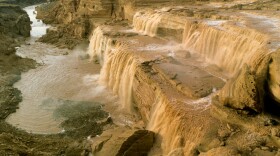Montezuma Well is easy to find down in the Verde Valley–it’s located right at the intersection of geology and biology. The blue-green pool–120 yards wide, cupped in a perfectly round sinkhole–is startling in the middle of a mesquite desert.
Because travertine deposits have formed the rims, you have to walk up to look down to the pool. Lukewarm springs, fifty-five feet below the surface, deliver a million and a half gallons of water a day to the Well. Only these springs feed the pool; no other outside waters dilute it. On the southeast side you can listen to that water gurgle and chuckle as it escapes through an outlet called the swallet. Scramble around the backside of the Well to see the stream reemerge into a ditch, one people built a thousand years ago above Wet Beaver Creek to irrigate their corn and bean fields.
The story of Montezuma Well began much much earlier. Twelve million years ago, a large freshwater lake occupied most of central Arizona’s Verde Valley. Plants, animals, and a lot of calcium carbonate fell to the bottom of the lake, accumulating in a thick limestone layer called the Verde Formation. Ten million years later the lake drained, leaving that limestone behind. Groundwater flowing through the easily eroded rock carved a network of underground caverns. About 12,000 years ago, the roof of one of those caves collapsed and Montezuma Well was born.
This water is a stiff brew, laced with high concentrations of carbon dioxide and arsenic. Both mix with snowmelt that filters down from the high country to the north and east, and then bubbles up as springs at the bottom of the Well. Geology and hydrology dictate the chemistry--and the life--of Montezuma Well. Fish can’t live here because of the high levels of carbon dioxide--a hundred times more concentrated than a typical lake or river.
Those conditions have nurtured a strange and wonderful food chain, discovered some years ago by biologist Dean Blinn. In the daytime, red damselflies flit above Sonoran mud turtles that blissfully munch through floating mats of pondweed. Ducks and muskrats pay occasional visits. But at night, Montezuma Well turns into a real Star Wars bar. Tiny shrimpy creatures called amphipods swim to the surface at sunset to graze through algae. Water scorpions and giant water bugs come up after them. But the top predators are leeches that slither up from the bottom muck to feed on the amphipods at night. Instead of seeing their prey, the blind leeches feel vibrations from the amphipods jiggling around in the water. The lucky ones escape by hiding along the shoreline. But juvenile amphipods, heedlessly partying in mid-pond till all hours of the night, are especially vulnerable to the leeches.
Species here have adapted to geologically-dictated conditions that would be toxic to most other animals. The leeches wrap themselves in a slime membrane that has an arsenic concentration 50,000 times greater than in our bodies. Mud turtles snack on the leeches and, in turn, their shells are permeated with arsenic. Montezuma Well harbors the greatest concentration of endemic species of any spring in North America--species found nowhere else, all playing the wild cards geology dealt them many millions of years ago.








